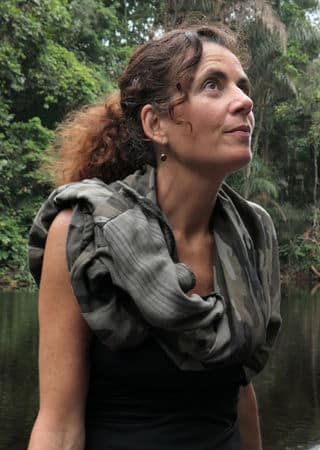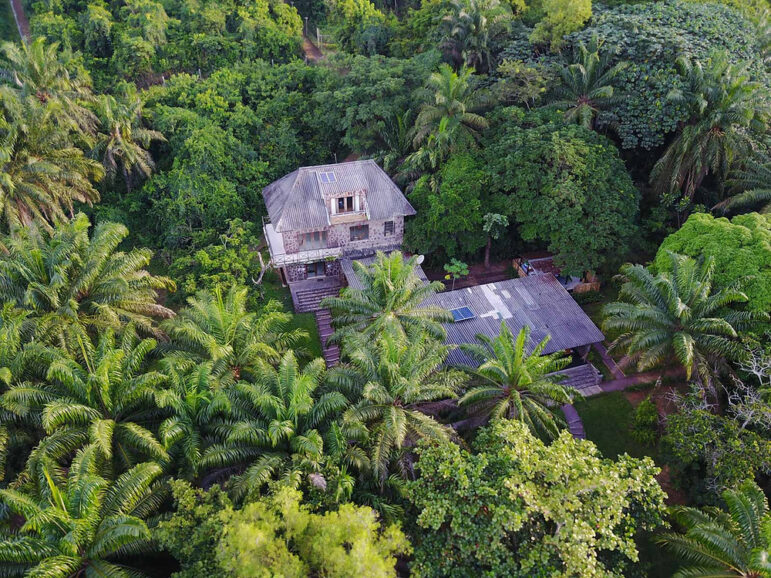
The magical rainforest setting of Lola ya Bonobo endangered ape sanctuary.
In an earlier blog post, I focused on why someone might want to travel for a magical eco-vacation at the Lola ya Bonobo endangered ape sanctuary, in Kinshasa, Democratic Republic of Congo (DRC). Now let’s turn to the practical considerations involved in going to the bonobo rainforest paradise.
The COVID-19 virus and all its ramifications have made travel less predictable and more subject to disruption than it has been for a long time. But that’s probably good preparation for any trip to the Congo! Travel to the DRC has always been complicated. If you’re braced for possible bumps in the road and can build as much flexibility as possible into both your arrangements and your mental attitude, that’s a great way to start.
After that, setting up a trip to Lola involves several key components. There are a few companies that organize tours to Congo, but we chose to plan our own trip in January of 2020.
Organizing your travel

Flights from Kigala, the capital of Rwanda, depart for Kinshasa several times a week.
At the moment, more than a dozen airlines provide regular service into N’Djili Airport (Kinshasa’s international hub, aka FIH).
These include daily flights offered by Ethiopian Airlines and Kenya Airways, as well as less frequent but nonstop options from Brussels, Paris, Entebbe, Kigali, Istanbul, and Johannesburg.

N’Djili Airport is the international hub for the DRC
Airline offerings can change at any time, of course, and that’s never been truer than at the moment. Online resources that can help track the available options include the website flightconnections.com, which provides a good initial overview.
For more detailed information into connection options and pricing I like to start with Google Flights and Skyscanner, followed by checking directly with the carriers’ websites.
Navigating the bureaucratic hurdles

They aren’t the fanciest visas in the world, but they can be difficult to obtain.
When my husband and I landed at N’Djili, all we had to do to walk out of the airport was show the immigration officials our passports, each containing a Congolese visa. Some young women dressed like nurses also asked for our proof of vaccination against yellow fever. Arrival thus felt like a breeze. But what preceded it was more nightmarish.
The only place that issues visas for American citizens to travel to the DRC is the Congolese embassy in Washington, D.C. You have to send the officials there not just money (at least $175 per person), but also your passport, two copies of the completed (complicated) visa-application, a letter of invitation from your host in the Congo, color photographs, copies of all your airline tickets, and a prepaid envelope. You’re supposed to submit this no more than 45 days before you leave on your trip. And then you must pray that it all gets processed and back to you on time.
I had heard at least one horror story from someone I knew, a major bonobo supporter, who had arranged a trip to Lola for a group of family and friends. She had paid for all the non-refundable airline tickets, applied for all the visas – and then learned the critical stamps would not be available in time. She had to cancel the trip and forfeit all that airfare.
My husband and I waited with bated breath.
In an attempt to avoid this, I turned to a recommended visa-processing agency (Travel Visa Pro) and paid for expedited service. To obtain the requisite letter of invitation, I corresponded with the staff at Lola and sent them all the information they needed. Then my husband and I waited with bated breath.
When we finally received the crucial documents, we understood why the sanctuary charges a hefty processing fee. The completed letter bore more stamps and signatures than I had ever seen on any other piece of government paperwork. We later learned that collecting them all required shocking expenditures of time and patience.

Our letters of introduction, necessary to get visas. Note all the official stamps and signatures required.
Vaccines and medication
My husband and I had been immunized against yellow fever years ago, before a trip to Peru. That vaccine provides lifelong protection so all we had to do was dig up our yellow fever vaccine cards.
But while yellow fever is the only vaccine currently required to enter the Congo, it is hardly the only health consideration. Mercifully, The CDC website says travelers face little risk of contracting Covid there. But even fully vaccinated travelers must undergo a Covid test upon arrival in Kinshasa. To learn if these requirements have changed, one resource is the Skyscanner Travel Restrictions page.
Beyond the coronavirus, travelers to the DRC are advised to make sure all their routine vaccines (e.g. polio, shingles, flu, measles, mumps, rubella, chickenpox, diphtheria, tetanus, and pertussis) are current. The CDC further recommends that travelers to the DRC get vaccinated against hepatitis A, hepatitis B, meningitis, and typhoid.
Malaria is endemic, so taking antimalarial medication is strongly recommended. There are a number of drugs for preventing malaria, all of which you must start before your trip. The CDC gives detailed information on the options.
No vaccinations exist for African sleeping sickness, tick-bite fever, chikungunya, dengue, leishmaniasis, plague, Ebola, Marburg hemorrhagic fever, monkeypox, hantavirus, or TB, but all these diseases can be found in the Congo. Wearing the proper clothing, using insect repellent, and taking other common-sense measures can provide a lot of protection.
Steve and I suffered no adverse health consequences from our trip. But in my opinion, consultation with a knowledgeable travel-medicine specialist is essential before any adventure in the Congo.
From the Airport to the Bonobos
Once we were out of the airport, our visit to the sanctuary was flawless. The Visitor’s Guide to the sanctuary that Lola provided in advance of our trip answered most of my questions and prepared me for what we would experience.

We were greeted at the airport and driven to the sanctuary by Constant.
The timing of our flight’s arrival from Rwanda also simplified things. I had chosen it in part because it was scheduled to land in Kinshasa shortly before noon and thus hopefully would avoid any evening curfews such as those imposed during parts of the pandemic. We also had paid the $120 fee charged by the sanctuary for transport from the airport, and our driver, Constant, was waiting to greet us.
Is it Safe?
The question we got most often about visiting Congo was, “Is it safe?” The answer to this is complicated. The U.S.State Department advises citizens not to travel to North Kivu, Ituri, the eastern region, and the three Kasai provinces due to “crime, civil unrest, terrorism, armed conflict, and kidnapping.”

A sense of style is often evident.

A Kinshasa street scene
Those provinces are on the opposite side of the country from Lola ya Bonobo and the capital, Kinshasa. (Keep in mind that the DRC is the second largest nation in Africa – nearly a million square miles. ) Even so, the U.S. State Department warns of crime and the potential for demonstrations to turn violent in Kinshasa. We read the advisory fully and made a fully informed decision. Steve and I felt comfortable going because we have a relatively high tolerance of risk.
If it had cost more and taken more work to get there than most trips do, that made the experience all the sweeter.
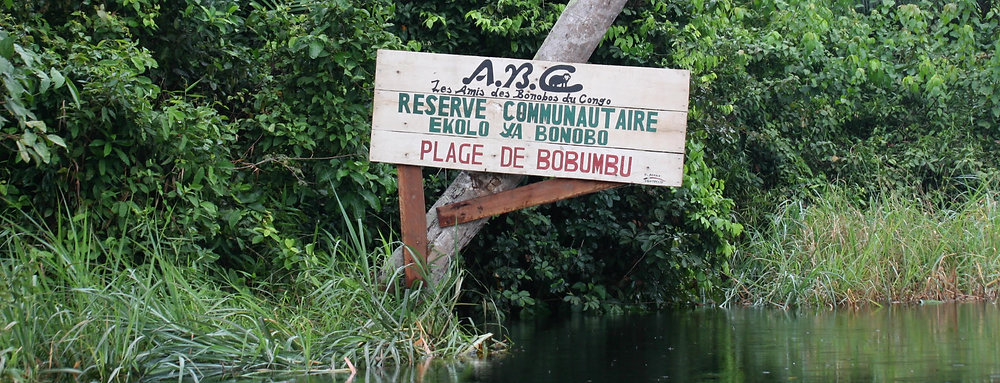
Bonobo Beach at Lola ya Bonobo sanctuary
Jeannette De Wyze was a journalist at the San Diego Reader, where she wrote cover stories and news articles for 30 years. Today she’s a bonobo lover and supporter and the volunteer liaison between Women’s Empowerment International and the Nyaka Grannies Project in Uganda. She also raises puppies to be service dogs for Canine Companions for Independence and is an active blogger.
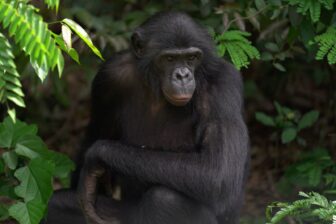 Kendra is a creative problem-solver who provides executive and operational support across the organization. As Executive Assistant to Ariel Rogers, she manages scheduling, communications, and day-to-day priorities while also supporting the development and communications teams with administrative and operational needs.
Kendra is a creative problem-solver who provides executive and operational support across the organization. As Executive Assistant to Ariel Rogers, she manages scheduling, communications, and day-to-day priorities while also supporting the development and communications teams with administrative and operational needs.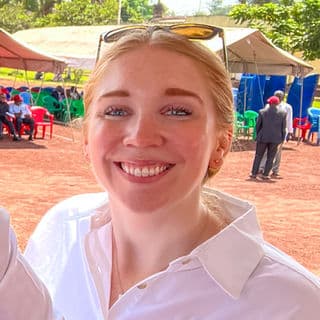 Kathleen Cook brings more than nine years of experience working across Africa, with a focus on the Democratic Republic of Congo, where she has traveled over twenty times to support projects spanning conservation, clean energy, and community development. Her career has centered around using storytelling, strategic marketing, and relationship-building to create meaningful impact.
Kathleen Cook brings more than nine years of experience working across Africa, with a focus on the Democratic Republic of Congo, where she has traveled over twenty times to support projects spanning conservation, clean energy, and community development. Her career has centered around using storytelling, strategic marketing, and relationship-building to create meaningful impact.